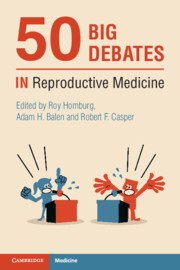Book contents
- 50 Big Debates in Reproductive Medicine
- Series page
- 50 Big Debates in Reproductive Medicine
- Copyright page
- Contents
- Contributors
- Foreword
- Introduction
- Section I Limits for IVF
- Section II IVF Add-ons
- Section III The Best Policy
- Section IV Embryology
- 24A ICSI Should Be Used for All IVF Cycles
- 24B ICSI Should Be Used for All IVF Cycles
- 25A Embryo Morphokinetic Analysis (Time-Lapse Imaging) Is Helpful in Selecting Euploid Blastocysts
- 25B Embryo Morphokinetic Analysis (Time-Lapse Imaging) Is Helpful in Selecting Euploid Blastocysts
- 26A Time-Lapse Imaging Should Be a Routine Procedure in Clinical Embryology
- 26B Time-Lapse Imaging Should Be a Routine Procedure in Clinical Embryology
- 27A Artificial Intelligence Is Useful for Embryo Selection in IVF
- 27B Artificial Intelligence Is Useful for Embryo Selection in IVF
- 28A There Is No Need to Take Embryos Out of the Incubator until the Day of Embryo Transfer
- 28B There Is No Need to Take Embryos Out of the Incubator until the Day of Embryo Transfer
- 29A Blastocyst Culture Should Be a Routine in All IVF Cycles
- 29B Blastocyst Culture Should Be a Routine in All IVF Cycles
- Section V Ethics and Statistics
- Section VI Male-factor Infertility
- Section VII Genetics
- Section VIII Ovarian Stimulation
- Section IX Hormones and the Environment
- Index
- References
29B - Blastocyst Culture Should Be a Routine in All IVF Cycles
Against
from Section IV - Embryology
Published online by Cambridge University Press: 25 November 2021
- 50 Big Debates in Reproductive Medicine
- Series page
- 50 Big Debates in Reproductive Medicine
- Copyright page
- Contents
- Contributors
- Foreword
- Introduction
- Section I Limits for IVF
- Section II IVF Add-ons
- Section III The Best Policy
- Section IV Embryology
- 24A ICSI Should Be Used for All IVF Cycles
- 24B ICSI Should Be Used for All IVF Cycles
- 25A Embryo Morphokinetic Analysis (Time-Lapse Imaging) Is Helpful in Selecting Euploid Blastocysts
- 25B Embryo Morphokinetic Analysis (Time-Lapse Imaging) Is Helpful in Selecting Euploid Blastocysts
- 26A Time-Lapse Imaging Should Be a Routine Procedure in Clinical Embryology
- 26B Time-Lapse Imaging Should Be a Routine Procedure in Clinical Embryology
- 27A Artificial Intelligence Is Useful for Embryo Selection in IVF
- 27B Artificial Intelligence Is Useful for Embryo Selection in IVF
- 28A There Is No Need to Take Embryos Out of the Incubator until the Day of Embryo Transfer
- 28B There Is No Need to Take Embryos Out of the Incubator until the Day of Embryo Transfer
- 29A Blastocyst Culture Should Be a Routine in All IVF Cycles
- 29B Blastocyst Culture Should Be a Routine in All IVF Cycles
- Section V Ethics and Statistics
- Section VI Male-factor Infertility
- Section VII Genetics
- Section VIII Ovarian Stimulation
- Section IX Hormones and the Environment
- Index
- References
Summary
Blastocyst culture has increased immensely in the last decade and is now routine practice; this has resulted in some benefits such as increased pregnancy rate per embryo transferred compared to cleavage stage transfer and a decrease in multiple pregnancy rates without a decrease in pregnancy rates overall when a single blastocyst is transferred. Potential disadvantages of blastocyst transfer include increased cycle cancellation rates, an altered sex ratio (favouring males), a reduction in embryo cryopreservation rates and an increase in preterm birth rates. Crucially, there is no robust evidence that blastocyst culture and transfer results in equal cumulative pregnancy rates compared to cleavage stage transfer, meaning that blastocyst transfer may be detrimental in some cases. Ultimately there is no robust evidence that all embryos that fail to blastulate in-vitro would do so in-vivo, and so centres should continue to utilise treatment algorithms that include both blastocyst and cleavage stage transfer options.
- Type
- Chapter
- Information
- 50 Big Debates in Reproductive Medicine , pp. 153 - 155Publisher: Cambridge University PressPrint publication year: 2021



